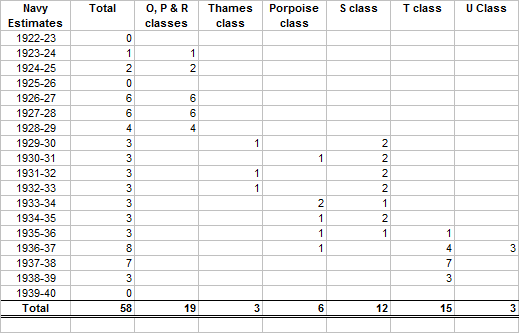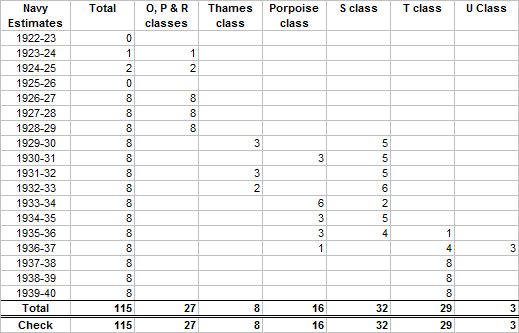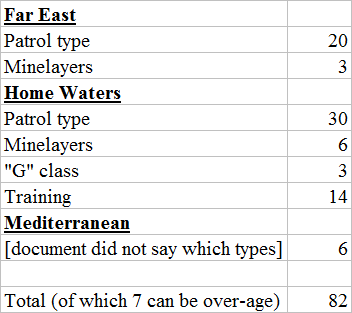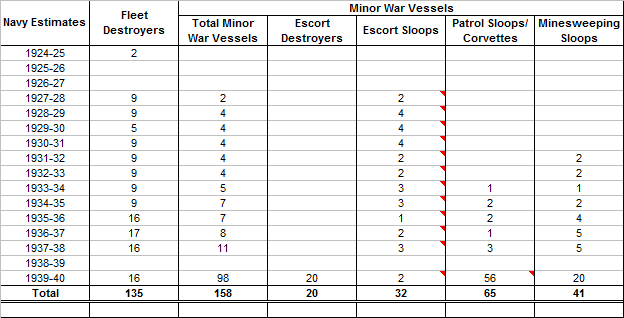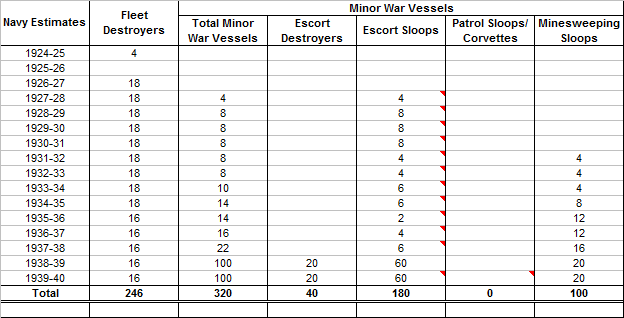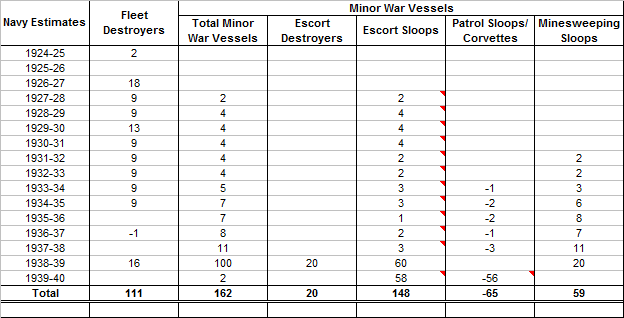Cruisers
Introduction
In the
"Real World" the British Commonwealth had 65 cruisers on 03.09.39 plus another 27 that were building, on order or planned. However, in this
"Version of History" the British Commonwealth had 82 cruisers on that date plus another 28 that were building, on order or planned. Two things made this possible. Firstly there was no Geddes Axe and British Government taxation & spending were maintained at 1921-22 levels from 1922-23 to the middle 1930s. Secondly, there was no 1930 London Naval Treaty or a less restrictive Treaty which didn't have tonnage quotas for cruisers (or submarines or destroyers).
Cruiser Requirements
In the
"Real World" the Admiralty wanted 70 cruisers (of which 10 could be over-age) from 1924 to the middle 1930s to fight a war against one first class naval power (Japan) and 100 cruisers (of which 15 could be over-age) from the middle 1930s to 03.09.39 to fight a war against two first class naval powers (Germany and Japan). The 70 cruiser force consisted of 25 fleet cruisers and 45 trade protection ships. The 100 cruiser force consisted of 55 fleet cruisers & 45 trade protection and the 55 fleet cruisers included 30 in home waters & 25 in the Far East. But the First London Naval Treaty of 1930 limited the British Commonwealth to 339,000 tons of cruisers which was enough to maintain a force of 50 ships. The Second London Naval Treaty which came into effect on 01.01.37 abolished the cruiser tonnage quota (and the submarine tonnage quota & the destroyer tonnage quota) but there was only time to increase the number of cruisers from the 56 that actually existed at the end of 1936 to 65 by 03.09.39 which was done by not scrapping any ships during the intervening period.
In 1924 a cruiser became over-age 15 years after its date of completion, which required a building rate of 4 ships a year to maintain a force of 60 under-age cruisers, but the Government wouldn't provide the money to build 4 ships a year. Therefore, the Admiralty increased the age limit to 20 years after a cruiser's date of completion in 1926. The new age limit required a building rate of 3 ships a year to maintain a force of 60 under-age cruisers and 4¼ ships a year (i.e. 4 a year plus a 5th every leap year) to maintain a force of 85 under-age cruisers. The 20 year age limit became international law in 1930 when the First London Naval Treaty said that a surface vessel exceeding 3,000 tons but not exceeding 10,000 tons standard displacement was deemed to be
"over-age" after 16 years if laid down before 01.01.20 and after 20 years if laid down after 31.12.19. This rule was carried over into the Second London Naval Treaty of 1936.
In terms of numbers the Admiralty's cruiser requirements were exactly the same as the
"Real World" in this
"Version of History", but the age limit wasn't increased from 16 to 20 years until the middle 1930s. This was possible because the Government spent more money on defence between 01.03.22 & 31.03.36 and there was no 1930 London Naval Treaty or one that didn't have tonnage quotas for cruisers (and submarines & destroyers).
Cruiser Construction 1924-36
According to Conway's 1922-46 the British Empire had 50 cruisers at the end of 1921 which were completed 1909-21. However, one of the 50 was the Hawkins class cruiser Vindictive which was completed as an aircraft carrier in 1918 & wouldn't be converted back into a cruiser until 1923-25 and the Hawkins class cruiser Raleigh which would be wrecked on 08.08.22. Another 8 cruisers were under construction at the end of 1921 and they would be completed 1922-26. Thus there were 57 cruisers at the end of 1926 including 4 that were overage. Except that 7 were broken up 1923-26 which reduced the total to 50 of which 3 were over age.
By mid-1923 (according to Freidman) the Board of Admiralty was calling for 70 cruisers (of which 10 could be overage) to be ready by the target modernisation date of 1929. The Director of Pans proposed a building programme of eight 10,000-ton cruisers in 1924, 1925 & 1926 and 4 in each succeeding year. He assumed, also, a 3-year building time. That would give 28 large cruisers in 1929 and a total of 59 under-age ships at that time. He didn't say so but the 28 large cruisers in 1929 were the 4 surviving ships of the Hawkins class and the twenty-four 10,000 ton ships class laid down 1924-26 & completed 1927-29. However, according to my calculations there would have been 66 underage cruisers at the end of 1929. That is 42 completed 1914-26 and 24 County class completed 1927-29.
However, 37 cruisers were actually laid down at an average rate of 3 per year 1924-36 (and completed 1928-39) in the
"Real World" which was enough to maintain a force of 70 cruisers (including 60 less than 20 years of age). 64 cruisers were actually laid down at an average rate of 5 per year 1924-36 (and completed 1928-39) in this
"Version of History" which was enough to maintain a force of 70 cruisers (including 60 less than 15 years of age) because the ships were being built at the rate proposed in mid-1923.
The British Commonwealth had 56 cruisers at the end of 1936 in the
"Real World" including 20 that were more than 15 years old. Another 9 were under construction. They had been laid down 1934-36 and would be completed 1937-39. None of the existing ships would be discarded 1937-39 so the total at 03.09.39 was 65 cruisers including 25 that were more than 15 years old.
The British Commonwealth had 70 cruisers at the end of 1936 in this
"Version of History" including 11 that were more than 15 years old. Another 12 were under construction. They had been laid down 1934-36 and would be completed 1937-39. None of the existing ships would be discarded 1937-39 so the total at 03.09.39 was 82 cruisers including 15 that were more than 15 years old.
Cruiser Construction 1936-39
In the
"Real World" a total of 27 cruisers were laid down 1937-40 & completed 1940-44. This included 21 ships that were built under the 1936-37 to 1939-40 Navy Estimates and 6 ships built under the War Emergency Programme. Each ship took an average of 3 years to build.
In this
"Version of History" 28 cruisers were laid down 1937-40 & completed 1940-42. This included 24 ships that were built under the 1936-37 to 1939-40 Navy Estimates and 4 ships built under the War Emergency Programme. Each ship took an average of 2½ years to build.
The
"Version of History" ships were built after the cruiser requirement was increased from 70 (including 10 over age) to 100 (including 15 over age) with the new target to be reached by 31.03.42. They were also built after the age limit for cruisers was increased from 15 to 20 years and 14 of the 82 cruisers existing or under construction at the end of 1936 would be overage on 31.03.42. Thus 18 additional cruisers had to be laid down by March 1939 to meet the new target. This was done adding 4 ships to the 4 already being built under the 1936-37 Navy Estimates, building 8 ships under the 1937-38 Estimates and 8 more under the 1938-39 Estimates. This made a total of 20 ships (against a requirement for 18) so there would have been 12 underage cruisers on 31.03.42 instead of 14. The last 6 of these cruisers were actually laid down after 31.03.39 but were completed before 31.03.42 because they took about 2½ years each to build.
4 ships were built under the 1939-40 Estimates and another 4 were built under the War Emergency Programme. When they were ordered the plan was that they would be laid down by 31.03.40 and completed by 31.03.43. They were actually laid down between November 1939 & March 1940 and completed between May & September 1942.
Thus the total at 03.09.39 was 82 cruisers completed 1918-39 (including 10 over 20 years of age) with another 28 under construction or on order which would be completed 1940-42.
What Type of Cruiser?
I think 32 County class ships would have been ordered under the 1924-25 to 1928-29 Building Programmes instead of the 15 ships (13 County and 2 York class) that were built under these programmes in the
"Real World". Australia paid for 2 of the County class ships in both
"Versions of History".
I think 32 Edinburgh class ships would have been ordered under the 1929-30 to 1936-37 Building Programmes instead of the 22 ships (5 Leander, 3 Amphion, 4 Arethusa, 5 Southampton, 3 Gloucester and 2 Edinburgh class) that were build under these programmes in the
"Real World". Firstly, I think the RN would still decide that it preferred 6in guns to 8in guns for its cruisers, plus budgets were less restricted so if could continue to build 10,000 ton cruisers in the numbers it required and the ALT-1930 London Naval Treaty didn't have tonnage quotas for cruisers (or submarines or destroyers) so there was no legal impediment to prevent it from reaching its target of 700,000 tons of cruisers, i.e. 70 ships displacing 10,000 tons each.
The 28 cruisers that were laid down 1937-40 and completed 1940-42 were additional ships of the Edinburgh class. This was possible because of the extra building capacity which had been created/maintained 1924-36 in this
"Version of History" and because the 1936 London Naval Treaty of didn't reduce the size limit for cruisers from 10,000 tons to 8,000 tons.
The RN did have a requirement for smaller cruisers to work with the destroyer flotillas in the main fleets. However, I've decided to concentrate on larger ships for industrial reasons. For example, I think it would have been easier to build more triple 6" turrets than twin 5.25in turrets. This was partially because the former was already in production and also because the 16 Dido class ordered IOTL required 80 turrets (although not all were built) and 16 Edinburgh class needed 64 turrets.
The Old Cruisers
In the
"Real World" the RN & RAN had 28
"old" cruisers at 03.09.39 consisting of Adelaide, 13 C class, 8 D class, 2 E class and 4 Hawkins class. 25 out of 28 were more than 15 years old and 19 out of 28 were more than 20 years old. As far as I know the plan was to convert the 10 newest C class to AA ships. In the end one of the 3 oldest & 7 out of the 10 newest were converted. This may have been because some of the newer ships were sunk before they could be converted. Rearming the 8 D class with 4.5in DP guns was considered, but the war stopped the programme, although Delhi was rearmed with 5 single American 5in DP guns & 2 Mk 37 FCS. One of the Hawkins class had its 7.5in guns replaced by nine single 6in guns & also had eight 4in AA guns in 4 twin mountings fitted and World War II prevented the other 3 from being modernised along similar lines. I don't remember any plans to rearm the E class in Friedman and haven't checked.
In this
"Versions of History" the RN had 18
"old" cruisers at 03.09.39 consisting of 4 C class, 8 D class, 2 E class & 4 Hawkins class. 15 out of 18 were more than 15 years old and 10 out of 18 were more than 20 years old. All 4 C class and all 8 D classes had been rearmed with twin 4in AA guns. All 4 Hawkins class had been rearmed with nine single 6in guns and had also had eight 4in AA guns in 4 twin mountings fitted. Both E class had received eight 4in AA guns in 4 twin mountings by 03.09.39.
I did suggest rebuilding the Hawkins and E class along the lines of the Japanese Furukata class 1931-39 in the
"Optimize the RN for WWII" thread on alternatehistory.com earlier this year as a way of preserving some infrastructure and increasing the number of modern cruisers. I'm not doing it in this thread for three reasons.
- Although I have more money to spend in this thread I think there isn't enough money for this and the 10 battleships that I want to lay down 1931-36. (Which can be done because there wasn't a 1930 London Naval Treaty in this "Version of History" or if the was it didn't extend the battleship building holiday from the end of 1930 to the end of 1936.
- There is less need to rebuild them as 64 cruisers were laid down 1924-36 in this thread compared to 52 in the other thread.
- Prior to 1936 the first pair of Hawkins class would become overage 1933-34, followed by the second pair in 1939-40 and the E class in 1941. Even after the age limit was increased to 20 years and the size of the cruiser force was increased to 100 ships they'd be replaced between April 1942 & March 1945 by the 12 cruisers that were to be built under the 1939-40 to 1941-42 Estimates. Therefore, they wouldn't be in service for long enough to make the rebuilds cost effective. That's also why I've rearmed the D class with 4in AA guns instead of the 4.7in DP gun which I want the RN to standardise on. The heavier guns would have been more expensive and required more extensive modifications to the ship, which would have taken more time cost more money.
Organisation of the Cruiser Force
In the
"Real World" the Third Report of the D.R.C. (written in February 1936) recommended that the number of cruisers be increased from 50 (44 RN, 4 RAN & 2 NZ Div) to 70 (64 RN, 4 RAN & 2 NZ Div). It also recommended that the number of RN cruisers in full commission be increased from 30 to 44 which would allow the 7 existing cruiser squadrons to be increased from 4 ships to 5 and a second cruiser squadron (of 5 ships) to be formed in the Home Fleet.
The 14 extra cruisers would be distributed as follows:
Except, that there were 4 cruiser squadrons on the foreign stations and increasing them from 4 to 5 ships each produces a surplus of 2 ships.
In this
"Versions of History" there were 70 cruisers from 1929 to 1936 including 64 in the RN (44 in full commission & 20 in refit or reserve), 4 in the RAN and 2 in the NZ Division.
The 100 cruiser force included 10 maintained by the Dominions. I don't know how many of the remaining 90 would have been in full commission, refit or reserve. My guess is that it would have been 62 in full commission and 28 in refit or reserve. About 70% of the 64 RN cruisers in the 70-ship force were to be in full commission and 62 allows or 12 squadrons of 5 ships and 2 flagships for the destroyer flotillas in the main fleets.
The 65 cruisers in the Royal Navies at the outbreak of war included 8 maintained by the Dominions. That is the RAN had 6 and the NZ Division had 2. There would also have been 8 Dominion cruisers in this
"Version of History" but the RAN would have had 4 Edinburgh class instead of Adelaide & the 3 Amphions and the NZ Division would have had 2 Edinburgh class instead of 2 Leanders.
An Alternative Battle of the River Plate
Therefore, this
"Version of History's" Battle of the River Plate would have been the Real-Graff Spee fighting 4 RN & NZ Division ships instead of 3 consisting of 2 County and 2 Edinburgh class ships instead of one York and 2 Leander class ships with a total of 40 guns (16 x 8in & 24 x 6in) vice 22 (6 x 8in & 16 x 6in). My guess is that Graff Spee would have been quickly overwhelmed by the British ships and sunk before she could make Montevideo. Furthermore, she would have done less damage in return to the British ships than was done in the
"Real World".
Cruiser Construction by the other Naval Powers
Starting with the easy ones...
France and Italy
The size of the French and Italian cruiser (and submarine and destroyer) forces wasn't limited by the Real-1930 London Naval Treaty so I think they'd build 19 cruisers each in both
"Versions of History". Neither nation had the money to build more cruisers in this
"Version of History". Furthermore, a shortage of slipways prevented France from building more even if it wanted to and in fact delayed the construction of some of the ships (not just cruisers) that were built in the
"Real World" so France couldn't have built more cruisers in this
"Version of History" even if it wanted to.
I think that the cruisers built in the 1920s in this
"Version of History" would have been built to the same designs as the
"Real World" because the British only built heavy cruisers in both
"Versions of History". However, both navies may have built 10,000 ton light cruisers to match the cruisers of that type the British built in place of the Leander, Amphion & Arethusa classes. Therefore, France might have built 7 & ordered 3 ships of this type instead of the Emile Bertin, La Galissonniere & De Grasse classes and Italy might have built 6 & ordered 2 ships of this type instead of the Montecuccoli, Duca D'Aosta, Abruzzi & Ciano classes.
Germany
The Reichsmarine/Kriegsmarine was screwed good and proper in this
"Version of History" because before 1935 Germany was limited by the Treaty of Versailles to eight 6,000 ton light cruisers and after 1935 didn't have the industrial capacity to build more cruisers. Therefore, it would have been overwhelmed by the British Commonwealth's larger cruiser force.
The Anglo-German Naval Agreement of 1935 in both
"Versions of History" allowed Germany to have 35% of the British Commonwealth's tonnage of surface warships. In 1935 that allowed Germany to have 245,000 tons of cruisers in 1935 because the British were working towards a force of seventy 10,000 ton ships for a total of 700,000 tons. This increased to an allowance of 350,000 tons when the British decided to work to a total of one hundred 10,000 ton cruisers for a total of one million tons.
Therefore, in 1935 Germany had the right to build 11 Hipper class cruisers (35% of 320,000 tons is 112,000 tons) instead of 5 and another 97,400 tons of 6in gunned cruisers (35% of 380,000 is 133,000 tons less the 35,600 tons of 6in cruisers they already had). This jumped to 112,000 tons of 8in cruisers and 238,000 tons of 6in gunned cruisers in 1936 when the British Government announced its new target of a million tons of cruisers (100 ships each displacing 10,000 tons) of which 32 would still be armed with 8in guns and 68 would be armed with 6in guns.
However, Germany didn't have the industrial capacity to build any more cruisers in this
"Version of History" so they still had 8 cruisers on 03.09.39 (and were only able to complete one more) while the British Commonwealth had another 17 for a total of 82 instead of 65. Plus the total included 64 new cruisers instead of 37 and 14 of the new cruisers had heavier armaments.
Japan
Japan was free to build as many cruisers as it wanted between 1930 and 1936 in this
"Version of History" provided that they displaced no more than 10,000 tons and were armed with 8in or smaller guns. However, I believe that it didn't have the money or infrastructure to build more than the 6 ships that were built under the First and Second Fleet Replenishment Programmes in the
"Real World". Furthermore, Japan might not be able to build that many cruisers in this
"Version of History" because it also lays down 6 capital ships 1931-36 (as was allowed by the Washington Naval Treaty) because the 1930 London Naval Treaty doesn't extend the battleship building holiday from the end of 1930 to the end of 1936 in this
"Version of History". My guess is that the money saved from not rebuilding the 10 existing battleships in this
"Version of History" will be enough to pay for the 6 new capital ships. However, if I'm wrong fewer submarines, cruisers and destroyers would have been built 1930-36 to provide the extra money.
However, the cruisers that were built in this
"Version of History" would have been additional Takao class ships instead of the
"Real World's" Mogami and Tone class cruisers. On the other hand the Japanese had to rebuild the Mogami class twice. First to strengthen their weak hulls and second when the 6in guns they were completed with were replaced with 8in guns. My guess is that the first rebuilding won't be needed because they would have had incorporated the lessons learned from the Takao class ships that were built in the
"Real World" and the second rebuilding won't be necessary because they were built with 8in guns. Avoiding the two rebuilds would have given the IJN money and dockyard space that it could have used to build other ships.
The 2 Ibuki class would have been additional Takao class ships in this
"Version of History" too. Japan formed its heavy cruisers into divisions of 4 ships and the plan was that they and the 2 Tone class would have formed a fifth full-strength heavy cruiser division. The IJN wanted them built under the Third Fleet Replenishment Programme of 1937 but a shortage of money and building capacity delayed this for 4 years and they were eventually ordered as part of the Rapid Naval Armaments Supplementary Programme of 1941. That's one of the reason why I think Japan could not have built more cruisers 1930-36 even if the 1930 London Naval Treaty allowed it to.
Japan also built some smaller cruisers of the Agano and Oyodo classes to work with its destroyers and submarines in the
"Real World". These were built after the Japan left the Treaty System so all other things being equal there was not change to the number built. However, the RN was building more Edinburgh class instead of the Dido class in this
"Version of History" and the USN may be building a Super Atlanta or more Baltimore & Cleveland class light cruisers instead of the Real-Atlanta class which were their destroyer support cruisers. Therefore, the IJN might want a
"Super Agano" with nine 6in in 3 triple turrets instead of the Real-Agano with six 6in guns in 3 twin turrets or a Takao class cruiser armed with fifteen 6in guns in 5 triple turrets instead of ten 8in guns in 5 twin turrets.
The United States
The USA was free to build as many cruisers as it wanted between 1930 and 1936 in this
"Version of History" provided that they displaced no more than 10,000 tons and were armed with 8in or smaller guns. Furthermore, it didn't have the financial & infrastructure restrictions that I think would have prevented Japan from building more than 6 cruisers in this
"Version of History". However, Congress might not have provided the money in spite of the US Government's aspiration for naval parity with the British Commonwealth in all classes of warship and in spite of Britain completing 64 cruisers 1927-39 instead of 37 in this
"Version of History". My guess is that Congress would have provided the money to lay down 10 capital ships 1931-36 (as was allowed by the Washington Naval Treaty) because the 1930 London Naval Treaty doesn't extend the battleship building holiday from the end of 1930 to the end of 1936 in this
"Version of History" but it wouldn't have provided the money for more cruisers (or destroyers or submarines) and might even have provided less money for cruiser (and destroyer and submarine) construction.
This is probably a bit of wishful thinking, but the this
"Version of History" version of the Cleveland class light cruisers had the Baltimore class heavy cruisers hull and machinery which allowed them to carry a fifth triple 6in gun turret. As I understand it the Cleveland class began as an 8,000 ton design (as per the terms of the Real-1936 London Naval Treaty) but grew into the 10,000 ton design that was actually built. Therefore, in this
"Version of History" the class began as a 10,000 ton design (as per the terms of the Alternative-1936 London Naval Treaty) but grew into the 13,600 ton design that was actually built.
6 Cleveland class cruisers were converted into guided missile cruisers in both
"Versions of History" but the ships converted in this
"Version of History" had larger hulls which allowed more guns to be retained or a second Terrier or Talos launcher to be fitted. The resulting ships might have resembled Boston and Canberra, except that they had three triple 6in turrets forward instead of two triple 6in turrets forward. Unfortunately, in both
"Versions of History", the cost of the Vietnam War prevented them from having another refit in the late 1960s in which new radars & electronics would have fitted and their guided missile systems would have been modernised.
The 9 Independence class light fleet carriers of this "Version of History" were more capable ships because they were effectively converted Baltimore class heavy cruisers instead of converted Cleveland class light cruisers and therefore had longer & beamier hulls. This might not have made much difference in World War II, but it would have made them more useful after the war, especially for the French Navy which received 2 in the 1950s and the Spanish Navy which received one in the 1960s.
There might not have been an Atlanta class anti-aircraft cruiser in this
"Version of History" or at least they might have been built to a different design. The Real-Atlanta class (in common with the British Dido class and Japanese Agano class) was designed to work with the destroyer flotillas (hence the small size and large number of rapid fire guns) and replace the Omaha class light cruisers currently used in that role. However, with the RN building more Edinburghs instead of the Didos and the IJN possibly building a larger & more powerful version of the Agano class or versions of the Takao class armed with fifteen 6in guns the USN may have decided that a larger and more heavily armed version of Atlanta was needed or they should build more Cleveland class cruisers instead.
The End of Cruisers
But NOMISYURRUC will return with Destroyers
Which hopefully will take a lot less time to write
And not be six pages of A4 long in twelve part Times New Roman.

